
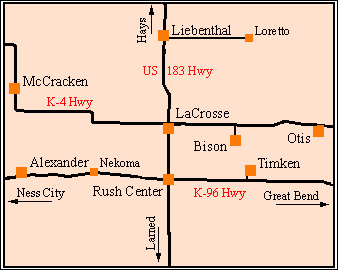
Rush County was established on December 5, 1874. According to the 2020 census, the population of the county was 2956. The county is divided into 12 townships and there are 8 incorporated cities, and 4 unincorporated towns. It is located in central Kansas and is bordered by Ellis County on the north, Barton County on the east, Pawnee County on the south, and Ness County on the west. Three major highways traverse the county, US Hwy 183, north and south, K-96 and K-4 east and west. Interstate Hwy. 70 is located 19 miles to the north.

Alexander The town is named after its founder, Alexander Harvey. The population of the city was 54 according to the 2020 census. Originally established on the Fort Hays-Fort Dodge Trail as a trading post known as “Harvey's Ranche,” Alexander is the oldest town in Rush County, founded in 1869. A state historical marker, located in the park along Highway K-96, tells about the Fort Hays-Fort Dodge Trail. In 2015, the "Alexander Wind Farm" was constructed south of Alexander at a cost of $85 million. 21 wind turbines generate 48-51 megawatts of power under purchase contracts by the Kansas City Board of Public Utilities and Yahoo! Inc.

Bison
Bison is named in honor of the native Bison (often called buffalo in error), once numerous across the prairies. The population of the city was 179 according to the 2020 census.
The community is known for its quaint tree-lined Main Street and large city park.
Located one mile west of the community is the former Lone Star School, oen of the oldest native limestone public buildings in the county. The former school is listed on the National Register of Historic Places.
United Methodist Church, W. 1st Street
Bison Community Library, 202 Main Street
Community Center, 202 Main Street
Bison Community Museum, 202 Main Street
Lone Star School, Avenue M
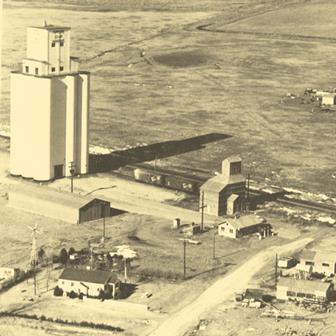
Hargrave Hargrave is an unincorporated community located 8 miles west of La Crosse on K-4 Hwy. It was named after John Hargrave, a Rush County farmer who served in the Kansas Legislature in the 1880s and was once superintendent of schools for Rush County. At one time, it was a stop for the Missouri Pacific Railroad. Today, only a few structures remain and the only business is a branch elevator for Midland Marketing Coop.
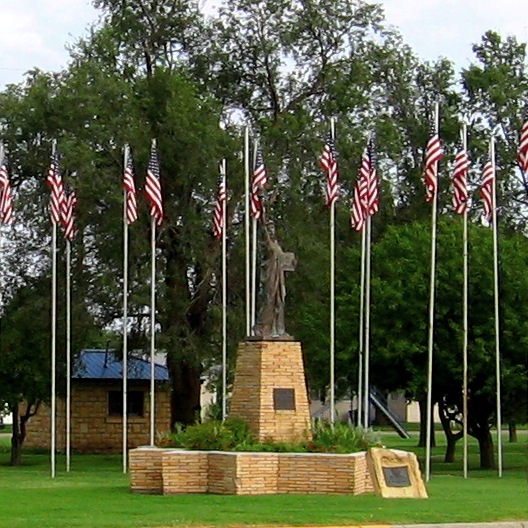
La Crosse
La Crosse is named after the town of La Crosse, Wisconsin. The population of the city was 166 according to the 2020 census.
LaCrosse is known as the "Barbed Wire Capital of the World"™.
LaCrosse is the county seat and home to major industries. For more information, visit the City of LaCrosse website.
First Christian Church, 619 Oak
First Lutheran Church, 304 Columbia
La Crosse Independent Baptist Church, 9th & Locust
Seventh-day Adventist Church, 8th and Columbia
St. Michael Catholic Church, 918 Lincoln
United Methodist Church, 3rd and Washington
USD 395, 616 Main
LaCrosse High School, 400 Washington
LaCrosse Elementary School, 511 Elm
Sixty Plus Club, 704 Main
Barnard Library, 521 Elm
Rush County Medical Clinic, 801 Locust
Rush County EMS, 119 West 9th
Rush County Health Department, 611 Peace
Rush County Memorial Hospital, 801 Locust
Locust Grove Village, 701 West 6th
Rush County Wellness Center, 611 Peace
Kansas Barbed Wire Museum, 120 W. 1st Street
Nekoma Bank Museum, 202 W. 1st Street
Post Rock Museum, 202 W. 1st Street
Rush County Historical Museum, 202 W. 1st Street
Pleasant Point School Museum, 202 W. 1st Street
Rush County Courthouse, 715 Elm Street

Liebenthal
Liebenthal was founded by the immigrants of the Saratov/Volga region of the Ukraine in Russia. It was named after the town of Liebenthal, Russia and means Love Valley in German.
The population of the city was 92 according to the 2020 census. It is the first Volga German settlement in the region. Today, the town is home to Pat's Beef Jerky, well-known across the United States.
Although having been twice gutted by fire, St. Joseph's Church stands as a monument to the devotion and perseverence of the Volga-German pioneers. The church grounds include a three-story native limestone school and rectory.
St. Joseph Catholic Church, 202 Main Street
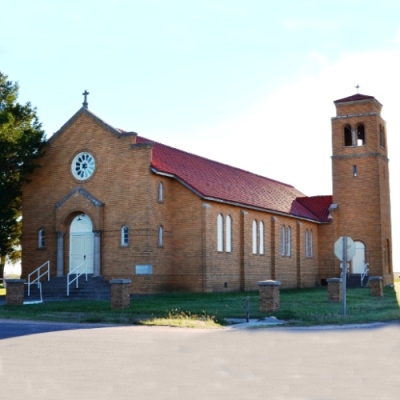
Loretto
Loretto was founded in 1876. It was originally named Illinois after the township, then Marianfeld, and finally, Loretto. The name comes from a city near the Adriatic Sea in Italy which is home to the Santa Casa di Loreto, a shrine believed to be the home of the Blessed Virgin Mary.
It is located 7.5 miles east of Liebenthal. Today, little remains of the community. The historic St. Mary's Help of Christian's Church is now privately owned.
St. Mary Help of Christians (closed)
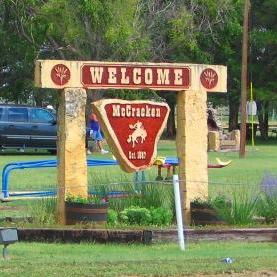
McCracken
McCracken was named after J.K. McCracken, the contractor in charge of building the Missouri Pacific Railroad and relative to railroad tycoon Jay Gould.
The population of the city was 152 according to the 2020 census. Today, McCracken annually hosts one of the states largest rodeos. The McCracken Rodeo has won distinction as KPRA Rodeo of the Year many years running.
Learn more about McCracken at McCracken Alumni.
McCracken Methodist Church, 307 W. 1st
St. Mary Catholic Church, 3rd & Ash
McCracken Library, 303 Main
McCracken Historical & Paper Moon Museum, S. Main Street
Fort Hays - Fort Dodge Trail, rural Rush County
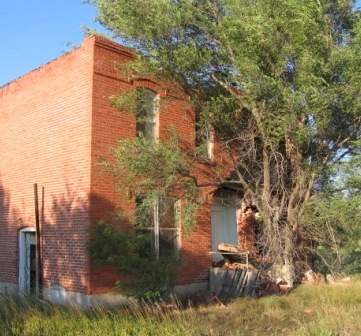
Nekoma Nekoma is said to be an Indian word meaning “mother”. The town was platted in 1884 by the railroad and a post office was established in 1890. Today, it is an unincorporated town on K-96 highway in southwestern Rush County. Following the closing of the post office, Nekoma has become a ghost town with only a few of the original buildings remaining. The only business remaining is the United Ag Service elevator (formerly Mid-State Farmers Coop.)

Otis
Otis was founded by railroad promoter Erastus C. Modderwell along the Missouri Pacific railroad. He named the town after his son, Otis Modderwell.
The population of the city was 296 according to the 2020 census. Today, Otis has one of the largest facilities in the United States for extracting helium from natural gas. Its products are shipped
throughout the United States and it is famous for providing helium for the Macy's Thanksgiving Day parade in New York.
Trinity Lutheran Church, 200 W. Ellen
Community Library, 122 S. Main Street
Senior Center/Community Center, 122 S. Main Street
USD 403, 301 W. Eagle
Otis-Bison Senior High School, 301 W. Eagle
Otis-Bison Middle School, 301 W. Eagle
Otis-Bison Elementary School, 216 N. 3rd
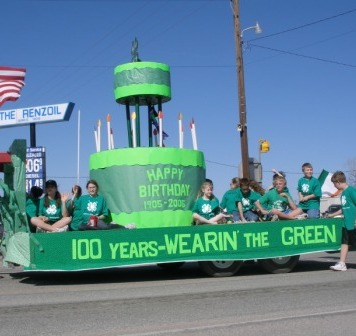
Rush Center
First known as Walnut City, Rush Center was originally situated in the center of Rush County until the southern tier of townships was transferred to Pawnee County prior to 1874.
The population of the city was 141 according to the 2020 census.
Rush Center annually hosts the largest Saint Patricks Day Parade in the area. Rush Center is also home to two of the county's largest industries; KBK Industries and Golden Belt Telephone.
Learn more about Rush Center at www.rushcounty.org/rushcenter.
Hope Lutheran Church, 308 S. Walnut
Community Library, 220 Washington
Walnut Valley Senior Center, 220 Washington
Walnut City Lodge #330 AF&AM, S. Elm Street
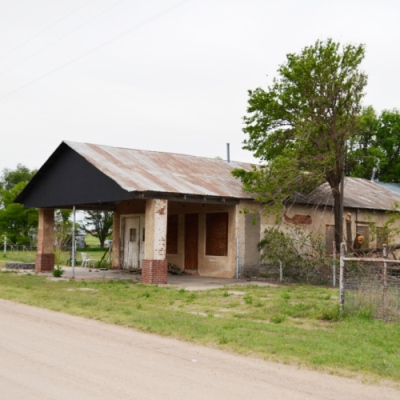
Shaffer
Shaffer was named after its first postmaster, Franklin P. Shaffer. It is an unincorporated community in southeastern Rush County.
Today, little more exists of the town than a few homes and buildings situated along the county road a short distance from Highway 96.
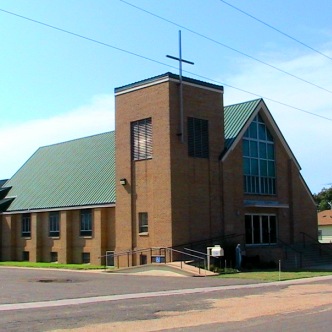
Timken
Timken is named after Henry Timken, the man who developed the Timken Roller Bearing. Henry Timken owned a considerable amount of land in the area at the time the Atchison Topeka & Santa Fe railroad was being built through the county.
The population of the city was 38 according to the 2020 census. Located south of the community is the Bohemian National Cemetery.
Holy Trinity Catholic Church, 103 S. Main